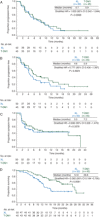Trastuzumab emtansine (T-DM1) versus lapatinib plus capecitabine in patients with HER2-positive metastatic breast cancer and central nervous system metastases: a retrospective, exploratory analysis in EMILIA
- PMID: 25355722
- PMCID: PMC4679405
- DOI: 10.1093/annonc/mdu486
Trastuzumab emtansine (T-DM1) versus lapatinib plus capecitabine in patients with HER2-positive metastatic breast cancer and central nervous system metastases: a retrospective, exploratory analysis in EMILIA
Abstract
Background: We characterized the incidence of central nervous system (CNS) metastases after treatment with trastuzumab emtansine (T-DM1) versus capecitabine-lapatinib (XL), and treatment efficacy among patients with pre-existing CNS metastases in the phase III EMILIA study.
Patients and methods: In EMILIA, patients with human epidermal growth factor receptor 2 (HER2)-positive advanced breast cancer previously treated with trastuzumab and a taxane were randomized to T-DM1 or XL until disease progression. Patients with treated, asymptomatic CNS metastases at baseline and patients developing postbaseline CNS metastases were identified retrospectively by independent review; exploratory analyses were carried out.
Results: Among 991 randomized patients (T-DM1 = 495; XL = 496), 95 (T-DM1 = 45; XL = 50) had CNS metastases at baseline. CNS progression occurred in 9 of 450 (2.0%) and 3 of 446 (0.7%) patients without CNS metastases at baseline in the T-DM1 and XL arms, respectively, and in 10 of 45 (22.2%) and 8 of 50 (16.0%) patients with CNS metastases at baseline. Among patients with CNS metastases at baseline, a significant improvement in overall survival (OS) was observed in the T-DM1 arm compared with the XL arm [hazard ratio (HR) = 0.38; P = 0.008; median, 26.8 versus 12.9 months]. Progression-free survival by independent review was similar in the two treatment arms (HR = 1.00; P = 1.000; median, 5.9 versus 5.7 months). Multivariate analyses demonstrated similar results. Grade ≥3 adverse events were reported in 48.8% and 63.3% of patients with CNS metastases at baseline administered T-DM1 and XL, respectively; no new safety signals were observed.
Conclusion: In this retrospective, exploratory analysis, the rate of CNS progression in patients with HER2-positive advanced breast cancer was similar for T-DM1 and for XL, and higher overall in patients with CNS metastases at baseline compared with those without CNS metastases at baseline. In patients with treated, asymptomatic CNS metastases at baseline, T-DM1 was associated with significantly improved OS compared with XL.
Keywords: T-DM1; ado-trastuzumab emtansine; central nervous system metastasis; metastatic breast cancer.
© The Author 2014. Published by Oxford University Press on behalf of the European Society for Medical Oncology. All rights reserved. For permissions, please email: journals.permissions@oup.com.
Figures

Comment in
-
Letter to the editor concerning 'Trastuzumab emtansine (T-DM1) versus lapatinib plus capecitabine in patients with HER2-positive metastatic breast cancer and central nervous system metastases: a retrospective, exploratory analysis in EMILIA'.Ann Oncol. 2015 May;26(5):1033-1034. doi: 10.1093/annonc/mdv040. Epub 2015 Jan 28. Ann Oncol. 2015. PMID: 25632067 No abstract available.
References
-
- Lin NU, Bellon JR, Winer EP. CNS metastases in breast cancer. J Clin Oncol. 2004;22:3608–3617. - PubMed
-
- Kennecke H, Yerushalmi R, Woods R, et al. Metastatic behavior of breast cancer subtypes. J Clin Oncol. 2010;28:3271–3277. - PubMed
-
- Eichler AF, Kuter I, Ryan P, et al. Survival in patients with brain metastases from breast cancer: the importance of HER-2 status. Cancer. 2008;112:2359–2367. - PubMed
-
- Brufsky AM, Mayer M, Rugo HS, et al. Central nervous system metastases in patients with HER2-positive metastatic breast cancer: incidence, treatment, and survival in patients from registHER. Clin Cancer Res. 2011;17:4834–4843. - PubMed
Publication types
MeSH terms
Substances
LinkOut - more resources
Full Text Sources
Other Literature Sources
Medical
Research Materials
Miscellaneous

